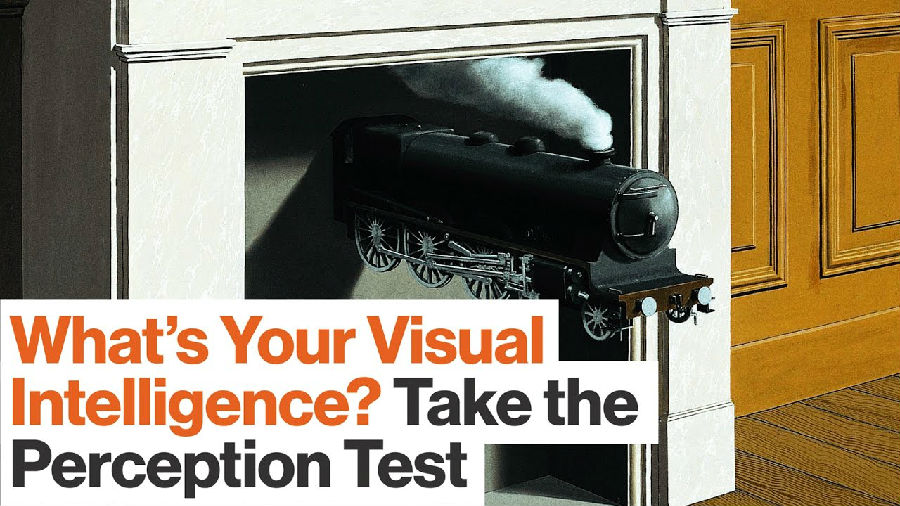(单词翻译:单击)
Visual intelligence is the concept that we see more than we can process
视觉智能是指我们无法处理所有视觉信息的时候
and it's the idea of thinking about what we see, taking in the information
它是人们思考并理解吸收他们所看到的信息的一种能力
and what do we really need to live our lives more purposefully and do our jobs more effectively.
它告诉我们要生活得更有目的性 工作更加高效
What I ask the people at The Art of Perception to do one of them is looking down at a piece of paper
我要求知觉艺术试验者们中的一个人低头看一张纸
and the other is looking at the painting and they have one minute to describe what it is that they see
另一位观察一幅画 然后他们有一分钟的时间把他们所看到的东西
to their partner and the partner has to sketch what are they hear.
描述给他们的同伴然后他们的同伴必须勾勒出他们所听到的内容
And it's not about the artwork, it's not about how well you draw it's how well can you describe a new set of unfamiliar data,
这实验与艺术作品无关 也跟你的画画技巧无关 它是测试你能否很好地描述一系列陌生的数据和信息
how well do you listen and how well do you take that articulation and transfer it to your own language.

你能否很好地听取那些信息并将那些信息转化成你自己的语言的一种能力
How many of you said there was a train coming out of a fireplace?
你们当中有多少人会说上面画着一辆从壁炉里跑出来的火车
And everyone raises his or her hands.
每一个人都举手了
And how many of you referenced smoke or steam in your discussion?
你们当中又有多少人在讨论中提到了烟或者汽
Lots of hands go up.
很多人举了手
And then I ask the question who articulated that there are no tracks under the train?
接着 我提出谁曾明确指出地指出火车下面没有铁轨
And a few astute people actually raised their hand and said I said there were no tracks under the train.
一些狡猾的人举了手 却是说我也没有指明火车下面没有铁轨
And then I ask who noticed and then articulated that there was no fire in the fireplace?
然后 我问谁注意到并且提到壁炉里面没有火
And hands go up. Not too many.
还是好几个举了手 但不是很多
Then we talk about other aspects in the painting.
接着 我们探讨起画中的其他方面
How many people mentioned the wood grain on the floor?
多少人提及木地板的纹理
Most people noticed the wood grain on the floor.
大部分人都注意到了这一点
How many people mentioned wainscoting, that kind of paneling on the walls?
多少人描述了那种镶嵌在墙上的护壁板
And I always have some decorative arts aficionados oh yes I know about wainscoting.
有人表示一直都有一些装潢艺术因子 哦 我知道护壁板
And then I say how many of you mentioned a mantle on the fireplace?
接下来我问谁提到过壁炉的遮布
Lots of hands go up. Who mentioned candlesticks? Lots of hands go up.
很多手都举着 谁说到了烛台 很多手举着
And then I ask how many of you said there were no candles in the candlesticks?
然后我又问有多少人提到烛台是空的
And people say oh no never got there.
人们都说哦没有没人留意
And then I ask what really observant nerd said it's 12:42 or 8:05 on the clock?
然后我又问 那种特别敏锐的人说出时钟上显示的是12:42还是8:05
Who got to mention the time?
谁提到了时间
And the reason I have that line of questioning is because this painting illustrates a very important concept
我问上面一系列问题的原因是那副画阐述了一个很重要的理念
that I transfer from emergency medicine to a much broader application.
它是我从急诊医学得来的并运用到更广泛的领域
And the idea is called the pertinent negative.
这个概念被称为否定相关
It's saying what isn't there in addition to what is there to actually give a more accurate picture of what you're looking at.
这个概念是指在描述一个具体事物的同时联想其相关事物 这样其实能使被观察的事物描述得更准确
So when you say I see a train coming out of the fireplace,
所以当你说我看见一列从壁炉里开出的火车顺便说一下
and by the way there are no tracks under the train and there is no fire in the fireplace,
那火车下面没有铁轨并且壁炉里面没有火
why would you attempt to say what's not there?
人们为什么要提到没有出现的事物
Because in my third-grade mind if you told me to draw a fireplace
因为如果你让我画一个壁炉 我的第三感会告诉我
I would draw two sticks and a fire and smoke in the fireplace unless you told me not to.
我要画两根柴火 一个火苗 和从壁炉里冒出来的一些烟 除非你特意提醒我不要那样画
And if you told me to draw a pair of candlesticks I'll draw candles with flames unless you tell me not to.
而当你让我画一对烛台时 我会在蜡烛上画上火苗除非你让我别这么做
So the pertinent negative is this wonderful concept that gives us a broader way of looking at something.
因此 否定相关是一个绝妙的概念 它赋予我们更具体地观察事物的能力
Instead of looking at something like this you look at it like this.
让否定相关来取代我们最简单的观察方法吧
And here's a example of how you apply that in the real world.
接下来 举个例子 关于如何将否定相关应用于现实
The pertinent negative in a medical situation is when someone comes into the emergency room
否定相关在医学领域中是指 当一个人被推进急诊室时
and they have all the symptoms, it appears to the physician they have all the symptoms of pneumonia.
医生必须想到病人存在患有肺炎的所有症状
Pneumonia has three symptoms.
肺炎具有三个症状
Symptom one is present, symptom two is present, but if symptom three is absent it's the pertinent negative.
在患者身上发现了症状一症状二 但没有第三种症状这就是急诊医学中的否定相关
You have to say septum three is not there therefore it's not pneumonia.
你大概会说因为第三症状不存在因此患者并没有感染肺炎
So in the real world, outside of medicine, how can we use this?
可是在现实世界中、在医学领域之外,我们应该如何使用这个否定相关
If we have an expectation of someone's behavior, you expect them to behave a certain way
如果我们对一个人的行为有一个预估 并且你期待他们按一定轨迹行事
and then they don't,you need to say it didn't happen.
但他们并没有 那就得说预估未曾发生
You're evaluating someone on the job.
当你对他人的工作进行评估
Well, you did A, B, and C very well but you didn't do D, E and F.
你将1、2、3项完成得很好 但没做4、5、6项
So it's looking at the affirmative and looking at the negative.
那么这就是在积极面和消极面看待问题了
And the pertinent negative is a wonderful tool.
同时否定相关也是一个精妙的工具
Missing person's cases you go to their homes, what's not there?
对于人口失踪案件 你到人家家里 房中缺少了什么
The cell phone is not there. The keys are not there. The wallet is not there.
手机不在 钥匙不在 钱包不在
You're going to have a very different search for that person if those things were present instead of absent.
你将通过对比这些事物是否存在 对此人 进行相当不同的搜查
So this Magritte painting gives us this great opportunity to talk about not just what we see
因此玛格丽特的画作为我们提供了一个机会 它不仅仅探讨肉眼可见的事物还有与之相关却未曾出现的事物
but what we don't see to give the person who can't see what we see a much more accurate description of what they're looking at.
能够让那些没有到现场的人 对于你所描述的信息有一个更具体准确的概念


